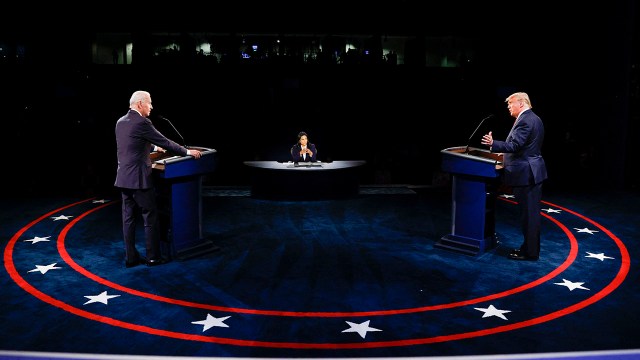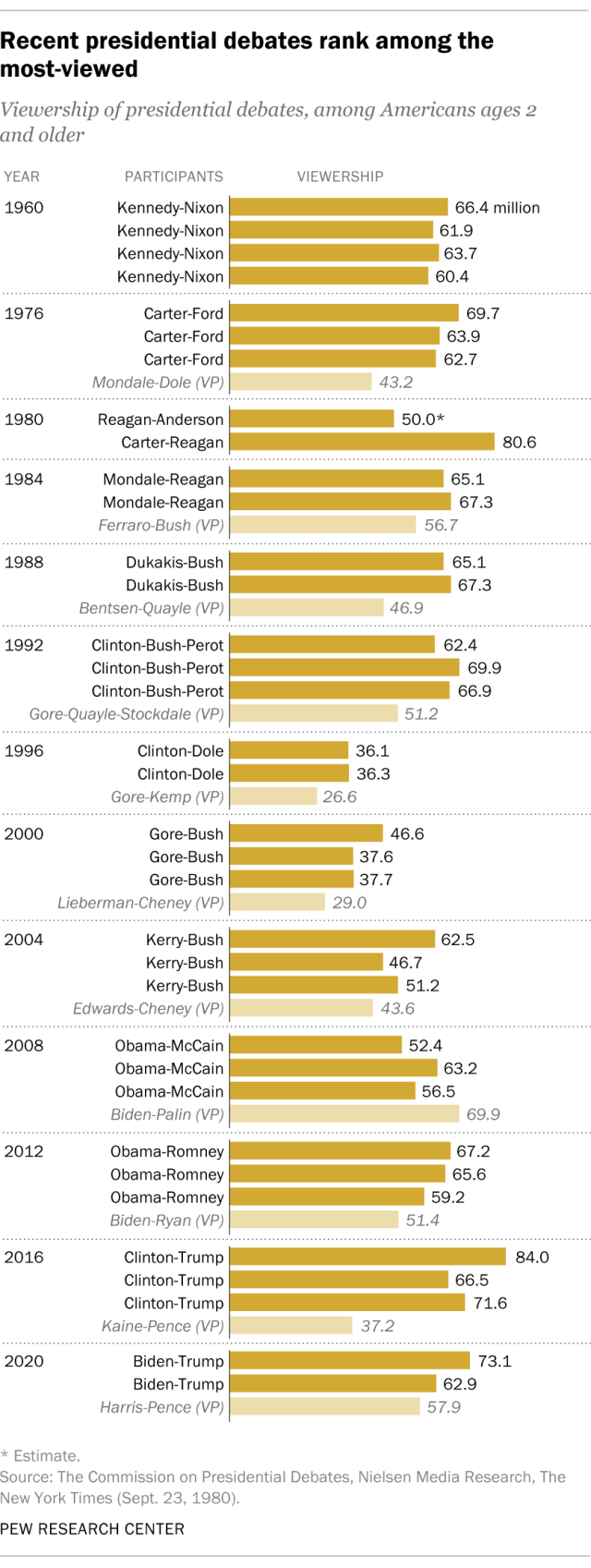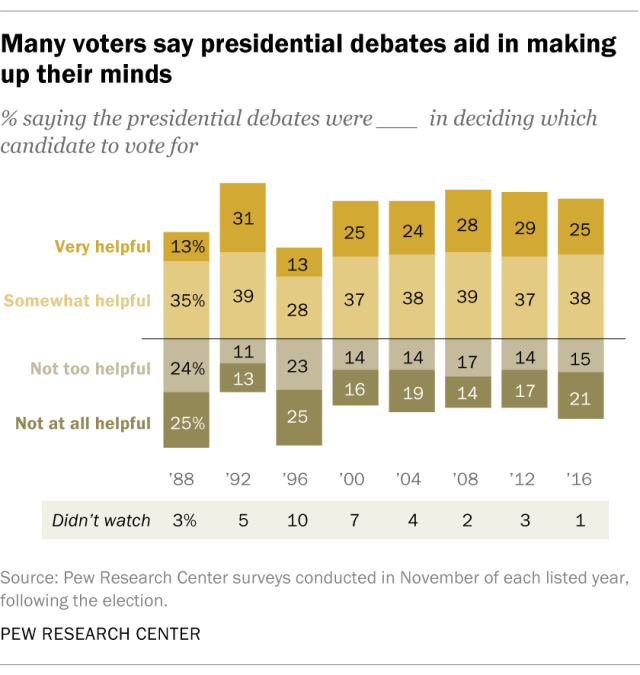
President Joe Biden and former President Donald Trump – the presumptive major-party nominees for the 2024 presidential election – will meet in the first of two planned debates on June 27.
That’s by far the earliest date any such debate has been staged – so early, in fact, that neither man will have been officially nominated yet. Since the first televised debates in 1960 between John F. Kennedy and Richard Nixon, all such events have been held in September or October.
The early date isn’t the only thing setting this year’s debates apart. The June debate is being organized by CNN and the Sept. 10 follow-up by ABC, bypassing the Commission on Presidential Debates. The commission had sponsored all presidential and vice presidential debates since 1988, sharing the broadcast with all channels that wanted to air it. (The commission has proposed a vice presidential debate for Sept. 25, but it’s not yet clear that the Biden and Trump campaigns will agree to participate.)
Presidential debates have long been criticized on both substantive and stylistic grounds, but they remain a major part of the campaign season. Here are six things to know before the first debate.
To lay some groundwork for the 2024 presidential debates, we looked back at the history of presidential and vice presidential debates.
Data on voters’ perceptions of the debates’ helpfulness and their decision-making process was drawn from previous Pew Research Center surveys. Refer to the links in the text for more methodological detail.
Viewership was based primarily on figures from Nielsen Media Research, supplemented by estimates from the Commission on Presidential Debates and, in one case, The New York Times. Other sources included the commission’s records on prior debates and contemporaneous media reports from various publications. Links to these sources can be found in the text of this analysis.
The debates draw a lot of viewers. Although viewership of the debates as a share of the total TV audience has broadly fallen over the decades, they can still attract more people than just about any other televised event besides the Super Bowl.

More than 73 million people watched at least some of the first Trump-Biden debate in 2020, according to Nielsen Media Research. (Nielsen defines audience as viewers ages 2 and older.) That’s the third-largest debate audience ever, trailing only the first debate between Hillary Clinton and Trump in 2016 (84 million viewers) and the 1980 debate between President Jimmy Carter and Ronald Reagan (80.6 million).
Older people were most likely to watch the first Trump-Biden debate, according to Nielsen. The debate drew a 42.7 rating among viewers ages 55 and older, versus 25.5 among 35- to 54-year-olds and 12.0 among 18- to 34-year-olds. (Nielsen ratings measure the percentage of television-owning households watching a particular program, but the company also collects data on individual viewers.)
This ratings data can be interpreted in various ways. On one hand, it seems to align with research that shows that older people are more likely to follow presidential election news. However, the Nielsen numbers only included people who watched the debates on traditional TV channels or via devices connected to TV sets (at home or outside the home) – not those who streamed the debates or watched them online. And according to a 2021 Pew Research Center study, only 34% of U.S. adults under 30 get TV through cable or satellite.
Ratings for the presidential debates have risen and fallen over the decades, according to Nielsen data. The four 1960 debates all had ratings of around 60.0, meaning roughly six-in-ten households with TV sets were tuned to the debates. When the debates were revived in 1976, their ratings were lower – generally around 50.0.
Ratings for the debates trended lower over the next two decades. The third debate between Al Gore and George W. Bush in 2000 had just a 25.9 rating. Since then, debate ratings have generally trended modestly upward: The first Biden-Trump debate in 2020 drew a 40.2 rating.

Voters find the debates useful, but not necessarily determinative. Pew Research Center conducted post-election surveys from 1988 through 2016. In most cases, six-in-ten or more voters said the debates were very or somewhat helpful in deciding which candidate to vote for.

The high point was 1992, when 70% of voters said the three debates that year between Bill Clinton, George H.W. Bush and Ross Perot were at least somewhat helpful. (The Center did not ask this question following the 2020 election.)
In 2016, for example, only 10% of voters said they had definitively made up their minds “during or just after” the presidential debates. By comparison, 11% said they’d decided later, in the days or weeks before or on Election Day. More (22%) said they had decided during or just after the summertime party conventions, and 42% said they had before the conventions.
The vice presidential debates are the undercard. In most years since 1976, when the candidates for vice president first had their own debate, the running mates have been runners-up when it comes to viewership.
In 2020, for example, 57.9 million people watched the debate between Vice President Mike Pence and then-Sen. Kamala Harris. That was 8% below the viewership of the lowest-rated Biden-Trump debate, though well above the 37.2 million who tuned in to the 2016 debate between Pence and Sen. Tim Kaine, the Democratic vice presidential hopeful.
The lone exception to this rule came in 2008, when more people (69.9 million) tuned in to the vice presidential debate between then-Sen. Biden and then-Alaska Gov. Sarah Palin than any of the three presidential debates between then-Sens. Barack Obama and John McCain.
Today’s televised debates don’t much resemble the first ones. From the first debates in 1960 between Kennedy and Nixon through the 1988 matchups between George H.W. Bush and Michael Dukakis, the candidates answered questions from panels of journalists. The moderator’s job was mostly to explain and enforce the ground rules and keep the proceedings moving.
But by the 1980s, the panel format was in trouble. Critics said it resembled a joint press conference more than an actual debate and that the journalist-panelists took too much time and attention away from the candidates. The campaigns bickered constantly over who could or could not be a moderator or panelist.
Finally, the League of Women Voters, which had organized the 1976, 1980 and 1984 debates, threw in the towel, leaving the job to the newly created Commission on Presidential Debates.
In 1992, the commission tried a variety of approaches: Along with two panel-style debates, it introduced a “town hall” event in which undecided voters asked the questions. That year’s vice presidential debate had a single moderator pose questions to the candidates.
Based on public feedback afterward, the commission decided to use only the single-moderator and town hall formats going forward. (The lone exception was a 2016 debate that was co-moderated by Anderson Cooper of CNN and Martha Raddatz of ABC News.)
Most of the moderators have been broadcast journalists. All but two of the debate moderators since 1960 have been prominent broadcast journalists. (The exceptions were James Hoge, editor-in-chief of the Chicago Sun-Times, who moderated the 1976 vice presidential debate, and USA Today Washington bureau chief Susan Page, who moderated the 2020 vice presidential debate.)
PBS journalists have moderated the most debates: 16, including 12 by the late Jim Lehrer. The only other person to have moderated more than two presidential or vice presidential debates is Bob Schieffer of CBS News (2004, 2008 and 2012).
Note: This is an update of a post originally published on Aug. 28, 2020.
